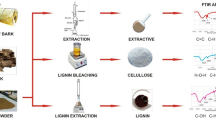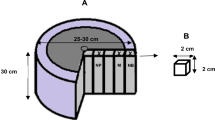Abstract
We compared the chemical components and essential oils of ancient buried Zhennan (Phoebe zhennan) wood with those in samples from living trees. After removal of the carbon layer the recovered Zhennan exhibited a dark green color, which differed from the yellow color of the living samples. Low molecular weight components (including hot-water and toluene-alcohol extractives), hemicellulose, and 1 % NaOH solubility in the recovered wood were greatly degraded. Degradation of cellulose was minor. Moreover, the ancient wood had somewhat more klason lignin than the modern wood. Fourier transform infrared (FTIR) analysis gave further evidence on the differences in chemical components. According to the GC–MS results, naphthalene derivatives were detected in the essential oils from both the modern and recovered wood. The delicate fragrance of the modern and recovered wood may be attributed to the aromatic constituents as identified by GC–MS.

Similar content being viewed by others
References
ASTM D 1103-60 (1971) Standard test method for alpha-cellulose in wood
ASTM D 1106-96 (1996a) Standard Test Method for acid-insoluble lignin in wood
ASTM D 1107-96 (1996c) Standard test method for ethanol-toluene solubility of wood
ASTM D 1110-96 (1996b). Standard test method for water solubility of wood
Blanchette R, Liyama K, Abad A, Cease K (1991) Ultrastructure of ancient buried wood from Japan. Holzforschung 45(3):161–168
Charles D, Simon J (1990) Comparison of extraction methods for the rapid determination of essential oil content and composition of basil. J Am Soc Hortic Sci 115(3):458–462
Iiyama K, Kasuya N, Tuyet L, Nakano J, Sakaguchi H (1988) Chemical characterization of ancient buried wood. Holzforschung 42(1):5–10
Li GY, Huang LH, Hse CY, Qin TF (2011) Chemical compositions, infrared spectroscopy, and X-ray diffractometry study on brown-rotted woods. Carbohydr Polym 85(3):560–564
Li XQ, Tang SQ, Long SL, Long HL, Zhang W (2013) Timber physical and mechanical properties of Phoebe zhennan. Journal of Northeast Forestry University 41(2):77–79
Lu XX, Chen YS, Hou BX, Zeng WM (2000) Characteristics of buried wood of China Fir. Chem Indus For Prod 20(2):59–64
Pan DR, Tai DS, Chen CL (1990) Comparative studies on chemical composition of wood components in recent and ancient woods of Bischofia polycarpa. Holzforschung 44(1):7–16
Pettersen R (1984) The chemical composition of wood. American Chemical Society, Washington DC, pp 57–126
Qi JQ, Hao JF, Ming RL (2008) A survey of buried wood resources and the importance of protecting in Sichuan. J Sichuan For Sci Technol 29(3):94–96
Wayman M, Azhar M, Koran Z (1971) Morphology and chemistry of two ancient woods. Wood Fiber Sci 3(3):153–165
Yan ZD, Lu SL, Guo FY, Yan J, He GH, Wang BY, Zhou ZS, Zhou ZB, Liu H, Yu CJ (2012) Chemical composition and corrosion resistance of the essential oil from buried wood of Hainan Cypress. Chem Ind For Prod 32(5):111–114
Zhang HR, Pang H, Shi JZ, Fu TZ, Liao B (2012) Investigation of liquefied wood residues based on cellulose, hemicellulose, and lignin. J Appl Polym Sci 123(2):850–856
Author information
Authors and Affiliations
Corresponding author
Additional information
Project funding: The project was supported by “Key Laboratory of Wood Industry and Furniture Engineering of Sichuan Provincial Colleges and Universities”.
The online version is available at http://www.springerlink.com
Jiulong Xie, Xingyan Huang and Ni Zhou have contributed equally to this work.
Corresponding editor: Yu Lei
Rights and permissions
About this article
Cite this article
Xie, J., Qi, J., Huang, X. et al. Comparative analysis of modern and ancient buried Phoebe zhennan wood: surface color, chemical components, infrared spectroscopy, and essential oil composition. J. For. Res. 26, 501–507 (2015). https://doi.org/10.1007/s11676-015-0034-z
Received:
Accepted:
Published:
Issue Date:
DOI: https://doi.org/10.1007/s11676-015-0034-z




